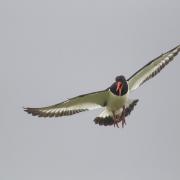Paul Hobson looks at another exotic addition to our native wildlife

Few would deny that we have a lot for which to thank iconic landscape gardener Lancelot ‘Capability’ Brown, particularly in the light of last year’s lectures, books and events to honour the tercentenary of his birth. However, not many people will associate him with the introduction of exotic ducks to the UK. Brown created over 170 stunning landscaped gardens and in many, if not the majority, he formed sculptured lakes and delightful ponds that fitted seamlessly into his idea of a traditional English landscape. The landscape was perfect but how could the owner add that extra dash of the exotic and elevate it into another realm? Well, the answer was simple – add a collection of exotic ducks. You might think that our own ducks, such as the gorgeous mallard, would be enough but when species like the alluring mandarin became available it’s not hard to see that getting ‘one up on the Joneses’ became a powerful driving force.
Mandarins are arguably the most beautiful duck in the world. The first recorded introduction into the UK from China or Japan was in the mid-eighteenth century by Alfred Ezra at Foxwarren Park in Surrey. Other ‘park’ owners followed suit and the exotic mandarin was added to many ornamental ponds and lakes across England over the course of the next hundred years. The natural home of the mandarin is the Far East, across parts of Russia, China and Japan.
Their preferred habitat is small ponds or slow-flowing streams and rivers in woody areas. They don’t like too large a lake and because they nest in holes in trees – although they do also like large bird boxes – they need trees around the areas they prefer. It is never a surprise that exotic aliens introduced to enrich the lives of the wealthy sometimes escape, and mandarins, like their imported cousins the Carolina wood duck from America, did this successfully, establishing a breeding population in South-East England. Over the last hundred years or so they have slowly spread and Derbyshire’s first recorded wild mandarin was in 1963, with the first successful breeding in 1986.
Today we can call the mandarin a common duck across much of lowland Derbyshire. They are frequently found on many small lakes, reservoirs and rivers such as at Osmaston, the rivers Dove, Lathkill, Bradford, Derwent and Wye, and at Calke Park, Chatsworth and Kedleston. In winter they tend to congregate together, Walton Dam being possibly one of the most significant wintering waters with up to 250 ducks.
There is no denying that the addition of the mandarin has elevated the excitement and joy of a walk for many of us. A few weeks ago I was watching a male mandarin sailing along the blue waters of Codnor Lake when a family stopped and asked me what duck it was. They were mesmerised, not only by the eye-punching colours but also by its elaborate and graceful feather structure. That male clearly made an impression.
The introduction (well, the escape) of exotic waterfowl into our countryside has not always been a positive thing. Egyptian and Canada geese have created many problems. So, can we be sure that mandarins will not end up being the next major conservation issue? At the moment the answer to this is still unclear. Mandarins live in a habitat that is not actually used by any other British ducks so at the moment conflict with them is not a problem. They nest in holes in trees, which in many areas may limit their spread unless we put up nest boxes specifically for them. However, tawny owls also nest in holes in trees and need holes about the same size as the mandarin does. We put up nest boxes for tawnies and I have heard that on at least three occasions mandarins have pushed out the tawnies, or got in there first and taken over the nest box. I suppose they may also do this with natural holes, which are never very common anywhere.
Mandarins have not been in Britain long enough to accrue any folk stories yet but in their native countries of China and Japan they are well regarded and loved. Feng shui considers them to be symbols of long and strong relationships. They crop up in many examples of Japanese art and I witnessed their symbolic presence on my recent trip to Japan. On many of the ornate Shinto and Buddhist temples animal carvings are prominent. I saw on at least three temples a pair of mandarins carved into a scene of flowing water, and pairs of mandarin ducks feature on many Japanese artworks. A Japanese folk story tells of a feudal lord who captured a male mandarin. The duck, removed from his mate, slowly declined and became sad. So the lord’s servant and her Samurai lover took pity on it and released it so that it could return to its mate. However, this angered the feudal lord who sentenced the servant girl and her lover to death.
This folk story of love and loyalty is well known in Japan and adds to the charm of this stunningly beautiful bird. There’s no denying that at least for now, the mandarin duck adds a touch of romance and colour to Derbyshire’s tree-shrouded ponds and rivers.



























